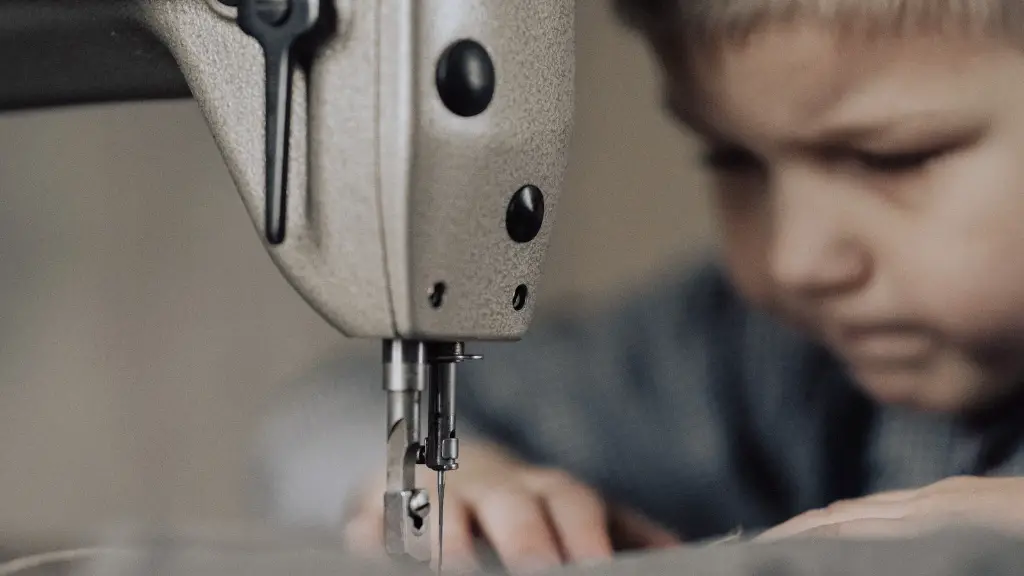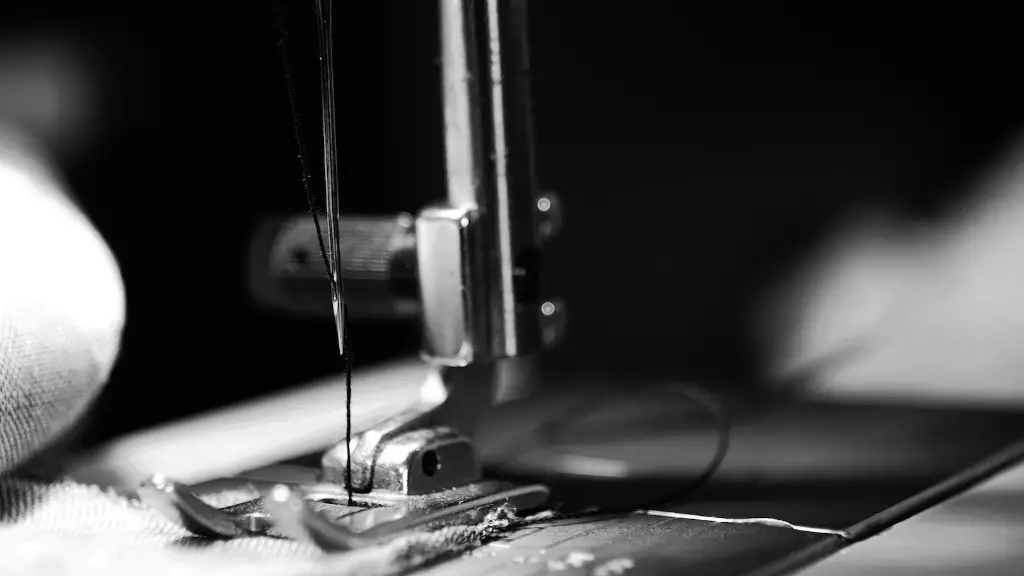It’s safe to say that for many of us, sewing machines are a classic household staple. Not only can sewing machines be incredibly useful, but they also serve as great tools for creativity, making quick and easy alterations and repairs a reality.
As with most machines, the range of what a sewing machine can do is quite varied. From alterations to clothing and home décor, to seamstresses and larger projects like kid’s apparel and quilting, a sewing machine can come in handy.
The most important aspect of using a sewing machine is making sure that you have the right model for the tasks you’re hoping to accomplish. For example, an industrial sewing machine is needed for creating high-end apparel, while a basic model is sufficient for beginner-level tasks. It’s also important to make sure that the machine is well maintained and that it’s always oiled properly.
The type of needle used matters too. Some models require specific needles that are only available through the manufacturer, while others can use generic models.
One of the great benefits of having a sewing machine is that it’s relatively low-cost. While it may cost a bit initially, it’s a great investment for repairs, alterations and larger projects. It also means that you won’t need to pay for expensive alterations or repairs that you can do yourself.
For those just starting out, there are a huge range of tutorials available for pretty much any task you could want to attempt. Sites like Youtube, Craftsy, and Sew Like A Pro offer some great tutorials for a range of techniques.
In addition, there are a ton of fabric stores that offer classes to get you going. It’s also a great way to get tips and tricks from experienced sewers.
Uses of A Sewing Machine
Sewing machines can be used for a variety of tasks, from mending clothes to creating handmade items. From making clothes to decorating pillows, a sewing machine is a great tool to have in ones arsenal. One of the most common uses for sewing machines is resewing clothing. With a sewing machine, one can take an old or damaged item of clothing and repair it easily.
Alterations and updates to clothing can also be done with a sewing machine. By adding on elements such as pockets or fabric panels, a sewing machine can help you create garments that are tailor-made for you. Curtains, tablecloths and other home décor items can also be made with the help of a sewing machine.
Quilting is another great use for a sewing machine. Not only is it great for creating beautiful quilts, but quilting is also a great way to save time and energy as it eliminates the need for labor-intensive handsewing. The piles of fabric pieces can quickly be pieced together with a sewing machine in a fraction of the time.
For adventurous sewing enthusiasts, sewing machines can also be used to create customized items that incorporate elements of creativity. From pieces of upcycled clothing to bags and wallets, no two pieces have to be the same when working with a sewing machine.
Difference Between Manual and Computerized Sewing Machines
Modern sewing machines come in two varieties – manual and computerized. Manual sewing machines are the oldest, and usually the most cost-effective option. They are extremely versatile and offer a great number of features such as adjustable stitch width, multiple needle positions and even a reverse switch.
Computerized sewing machines, on the other hand, come with a variety of advanced features such as automatic buttonholes and preprogrammed stitch patterns. The built-in screen will provide step-by-step instructions for certain projects, and some models even feature built-in tutorials and automated thread cutting.
In general, computerized machines are easier to use and offer more convenience, while manual models tend to be more versatile and cheaper. One should keep in mind that computerized machines can be more prone to errors due to their complexity, while manual models may require more maintenance.
Starting A Sewing Career
Thanks to the popularity of the internet, it’s never been easier to start a career as a seamstress or tailor. With the help of a sewing machine, you can start creating garments for yourself and for your friends as a hobby, and then eventually start selling them. Apart from that, you can also search for opportunities to work for existing businesses or to create your own clothing line.
However, before starting a career as a seamstress or tailor, it’s important to have proper training. Classes and classes are available either online or in person, and they can teach you the fundamentals of sewing as well as the more advanced techniques.
Apart from that, it’s important to have a proper toolkit. Having the right needles and threads, pinking shears, seam rippers, and clear rulers are all essential in order to get the job done properly. Also, you need to understand how to use the various fabrics and their different applications. Knowing these things will allow you to create the perfect garment or fabric item.
Pros and Cons of Sewing Machines
Sewing machines offer plenty of advantages as well as drawbacks that come with it. On the plus side, sewing machines eliminate the need for hand-sewing, meaning tasks can be completed much faster. Sewing machines also provide a great degree of accuracy, allowing you to precisely manage the stitch length, width and type according to your needs.
On the downside, sewing machines take up more space than hand-sewing and need to be properly maintained. The cost may also be a factor, as there is a wide range of machines out there with varying quality. In addition, sewing machines require electricity, so are not suitable for outdoor use.
Safety Tips for Sewing Machines
Safety is an important aspect when using a sewing machine. One of the most important tips is to use the right type of needle. Different materials require different types of needles, which should be replaced after a certain number of stitches. It’s also important to be aware of the potential dangers from sharp needles and pins.
It’s also important to follow the instructions for threading the machine properly. This will prevent tangling, breakages and other potential faults. Pay attention to how and where the thread is connected, and if possible try to use pre-wound spool and bobbins.
Another important safety tip is to never leave the machine unattended. When on, the machine should be monitored to make sure it’s functioning properly. This is especially important in the case of kids, as the power of the machine can be quite dangerous if used incorrectly.
Finally, always keep the body of the machine clean. Wipe away lint and dust after each use, as this can accumulate and cause the machine to overheat.
Benefits of Using Sewing Machines
The use of a sewing machine offers a number of benefits. Sewing machines can be used to create garments quickly and accurately, eliminating the need for tedious hand-sewing. This makes them great for creating large quantities of items quickly, as well as for creating custom-made pieces.
Sewing machines also provide great accuracy and consistency. By controlling stitch length and width, the stitch density can be tailored to the project and achieve professional-looking results. Furthermore, sewing machines help to reduce fabric waste as there is less chance for incorrect cutting or measuring.
Finally, sewing machines also offer great flexibility. Many modern machines offer a range of stitch types, from decorative to utilitarian, so a great variety of projects can be completed.
Uses of Sewing Machines in Schools
Using a sewing machine in school can be a great educational tool. It helps to teach patience and focus, as well as technical skills such as problem solving and hand-eye coordination. It can also be used as part of math lessons, as measuring and cutting is a big part of sewing.
Furthermore, using a sewing machine in schools is a great way to introduce students to textiles and get them interested in fashion. This can be applied to a wide range of courses, from designing apparel to home décor projects. It’s also a great way to create uniquely designed garments, as students can experiment with different textures, fabric types and color combinations.
Sewing machines can also be used to create useful items for practical use. Students can learn how to sew clothes and accessories, which can be sold or donated to the community. This helps to create a more sustainable mindset, as well as showing students the value of using their technical skills to help others.
Tips on Buying A Sewing Machine
When it comes to sewing machines, there are a few basic factors to consider. Firstly, consider your needs and budget. Different models come with varying features and price points, so you should decide what you’re looking for before you start your search.
Secondly, make sure to get the right type of machine for the kind of sewing tasks you’ll need it for. For example, a heavier duty machine may be better for heavier projects, while a lighter one may be perfect for smaller tasks.
Finally, do your research. There are lots of reviews and comparison articles available online that can help you determine which model is best for you. It’s also a great idea to speak to friends and family who have used sewing machines in the past. Their experiences can provide invaluable insight into what to look for when buying a machine.





